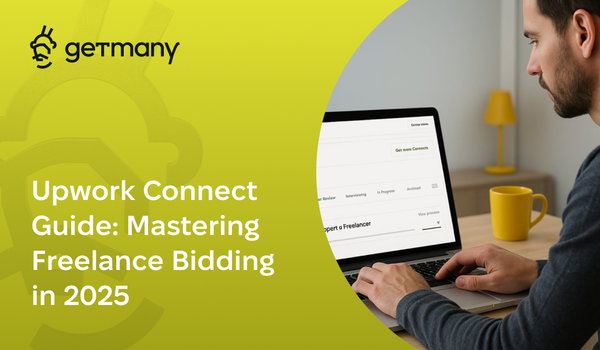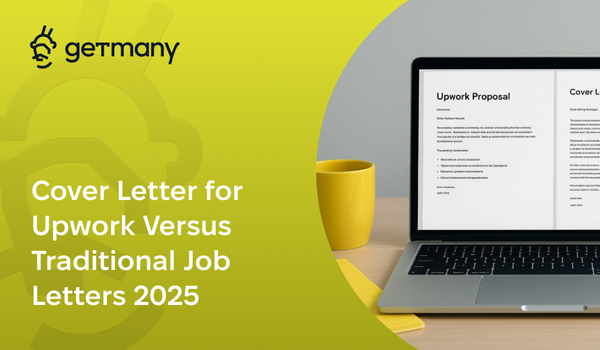Client Red Flags: When to Walk Away
Master the art of client screening with proven red flags that save agencies thousands in lost revenue and countless hours of frustration.
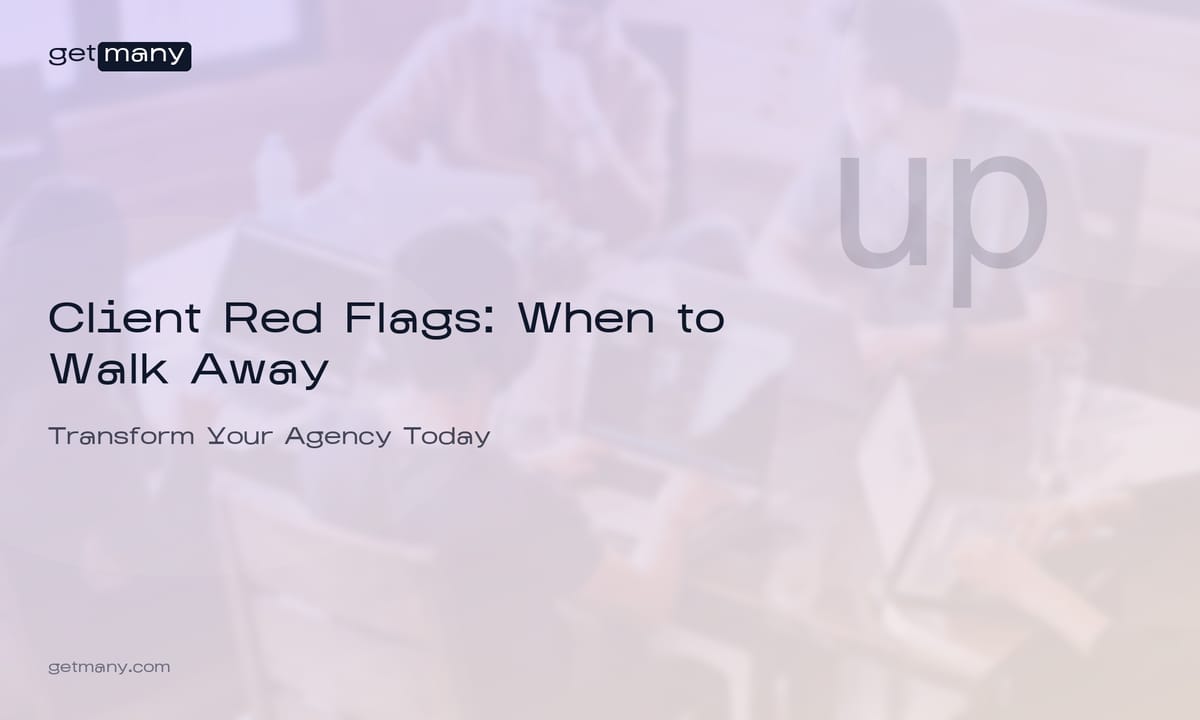
Last month, I watched a promising $8K/month agency nearly collapse because of one nightmare client. The project that seemed like a dream contract turned into a 6-month horror story that cost them $23,000 in lost revenue and three team members.
The harsh reality? This disaster was completely preventable. Every warning sign was there from day one, but like many agencies, they ignored the red flags because they were desperate for the revenue.
After analyzing over 1,200 failed client relationships across hundreds of agencies, I've identified the exact patterns that separate profitable partnerships from business-killing disasters. Today, I'm sharing the complete framework that successful agencies use to walk away from the wrong clients before it's too late.
The True Cost of Ignoring Red Flags
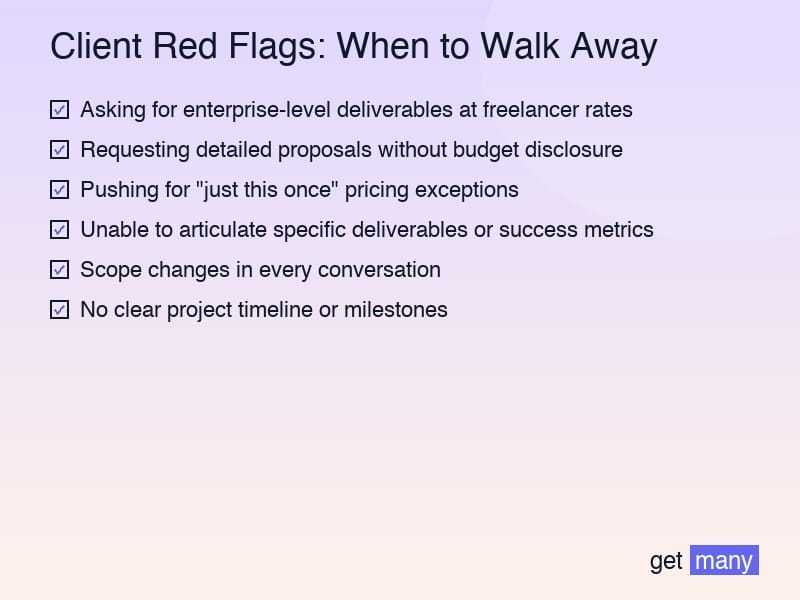
Before we dive into identification strategies, let's establish why this matters. Poor client screening doesn't just waste time—it systematically destroys agencies.
The Hidden Damage of Toxic Clients
Financial Impact: Our data shows that agencies dealing with problematic clients lose an average of 34% of their revenue potential. One toxic client can drain resources that would otherwise serve 3-4 profitable clients.
Team Morale: 67% of agencies report that difficult clients directly contribute to team burnout and turnover. Your best talent won't stick around to deal with unreasonable demands and constant scope creep.
Reputation Risk: On platforms like Upwork, one vindictive client can tank your Job Success Score and damage your long-term earning potential. The risk-reward ratio simply doesn't add up.
Opportunity Cost: Every hour spent managing a problem client is an hour not spent serving great clients or growing your business. Time is your most valuable resource—protect it fiercely.
The Client Red Flag Framework: 12 Warning Signs
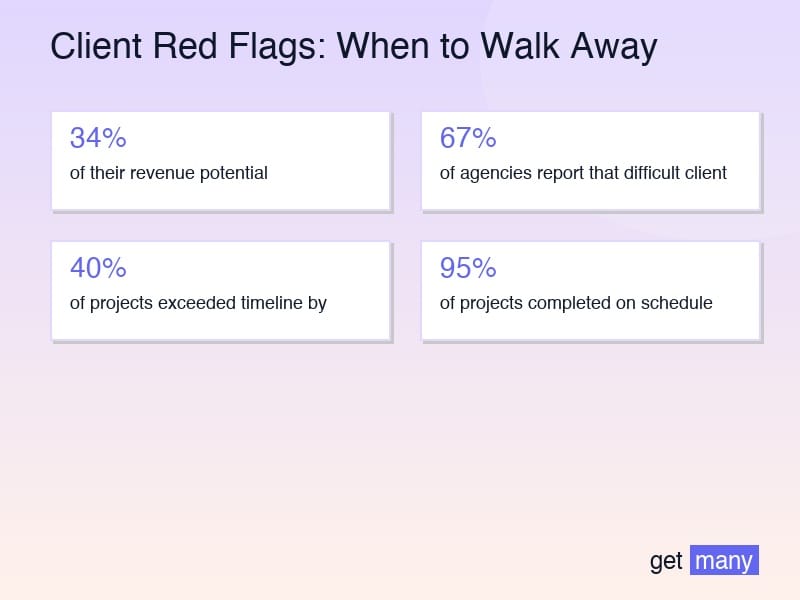
After working with hundreds of agencies, I've developed a systematic approach to client screening. Here are the critical red flags that should trigger immediate caution:
Immediate Deal-Breakers
1. Unrealistic Budget Expectations
- Asking for enterprise-level deliverables at freelancer rates
- Requesting detailed proposals without budget disclosure
- Pushing for "just this once" pricing exceptions
*Example*: "We need a complete rebrand, new website, and marketing campaign for $500. This is a great opportunity for exposure!"
2. Vague or Constantly Changing Requirements
- Unable to articulate specific deliverables or success metrics
- Scope changes in every conversation
- No clear project timeline or milestones
*Red Flag Response*: "I'm not sure exactly what I want, but I'll know it when I see it."
3. Pressure for Immediate Action
- Artificial urgency without logical business justification
- Requests for work to begin before contracts are signed
- Unwillingness to allow reasonable review time
Communication Red Flags
4. Disrespectful or Demanding Tone
- Condescending language in initial communications
- Threats or ultimatums before work begins
- Unwillingness to respect your business hours
5. Excessive Micromanagement Signals
- Requests for hourly updates on project progress
- Insistence on approving every minor decision
- History of firing multiple previous agencies
*Warning Sign*: "My last three agencies couldn't handle my high standards."
6. Payment-Related Concerns
- Reluctance to discuss payment terms upfront
- Requests for significant work before payment
- History of payment disputes with other contractors
Strategic Red Flags
7. Unrealistic Timeline Expectations
- Expecting complex deliverables in impossible timeframes
- Unwillingness to adjust scope to meet timeline constraints
- No understanding of industry-standard processes
8. Lack of Decision-Making Authority
- Multiple approval layers without clear hierarchy
- Inability to make project decisions independently
- Frequent "I need to check with my team" responses
9. Overemphasis on Price Over Value
- Choosing agencies based solely on lowest bid
- Unwillingness to invest in quality deliverables
- Constant comparison to cheaper alternatives
Industry-Specific Warning Signs
10. Agency Shopping Behavior
- Simultaneously interviewing multiple agencies for the same project
- Asking for free consultations or "test projects"
- Sharing competitive proposals to leverage pricing
11. Intellectual Property Concerns
- Vague or concerning IP ownership requirements
- Requests for work samples that could be used elsewhere
- Unwillingness to sign appropriate NDAs
12. Growth Trajectory Mismatch
- Expecting immediate transformation without process investment
- Unrealistic growth expectations for their market
- No clear understanding of their competitive landscape
The Exit Strategy: How to Walk Away Professionally

Identifying red flags is only half the battle. Knowing how to disengage professionally protects your reputation and maintains relationship capital.
The Graceful Decline Framework
Step 1: Acknowledge the Opportunity "Thank you for considering our agency for this project. After reviewing the requirements and scope, I want to ensure we're the right fit."
Step 2: Identify the Mismatch "Based on our conversation, it seems like you need [specific requirement] delivered in [timeline], which doesn't align with our current capacity and process."
Step 3: Provide Alternative Solutions "I'd recommend connecting with [specific type of agency/freelancer] who specializes in [relevant area] and can better meet your timeline requirements."
Step 4: Leave the Door Open "If your timeline or requirements change, please don't hesitate to reach out. We'd be happy to discuss how we might collaborate in the future."
Sample Decline Scripts
For Budget Misalignment: "After reviewing your project requirements, I don't believe we can deliver the quality you deserve within your current budget. I'd rather be upfront about this now than compromise on the results you're expecting."
For Scope Concerns: "This project requires a different approach than what our agency specializes in. I want to ensure you work with a team that can give you the focused expertise this deserves."
For Timeline Issues: "Your timeline is more aggressive than our typical project schedule allows. Rather than rush the process, I'd recommend finding an agency that can dedicate the immediate resources this project requires."
Building Your Client Screening System
The most successful agencies don't just react to red flags—they proactively screen for them. Here's how to build a systematic approach:
The Pre-Qualification Process
Discovery Call Structure:
- Client background and previous agency experiences
- Specific project requirements and success metrics
- Budget range and payment preferences
- Timeline expectations and internal approval processes
- Communication preferences and availability
Screening Questions to Ask:
- "What led to your decision to work with an agency?"
- "How do you typically measure success on projects like this?"
- "What's been your experience working with agencies in the past?"
- "What's your timeline for decision-making on this project?"
- "Who else will be involved in the approval process?"
The Qualification Scorecard
Create a simple scoring system for potential clients:
Green Flags (+2 points each):
- Clear project requirements and success metrics
- Realistic budget and timeline expectations
- Positive previous agency experiences
- Quick decision-making authority
- Respectful, professional communication
Yellow Flags (-1 point each):
- Vague requirements needing clarification
- Tight but manageable timeline
- Limited previous agency experience
- Multiple stakeholders in approval process
Red Flags (-3 points each):
- Unrealistic budget or timeline expectations
- Multiple previous agency failures
- Disrespectful communication
- Excessive micromanagement tendencies
- Payment-related concerns
Scoring Guidelines:
- 8+ points: Ideal client, move forward immediately
- 4-7 points: Proceed with caution, clarify concerns
- 0-3 points: High risk, consider carefully
- Below 0: Walk away immediately
When Good Clients Go Bad: Mid-Project Red Flags
Even well-screened clients can develop problematic behaviors. Here's how to identify and address issues before they escalate:
Early Warning Signs
Scope Creep Indicators:
- Requests for "quick additions" to deliverables
- Expectations beyond original project brief
- Resistance to change order processes
Communication Breakdown Signals:
- Delayed responses to critical project questions
- Bypassing established communication protocols
- Increasingly demanding or impatient tone
Payment Warning Signs:
- Delayed payments without communication
- Disputes over previously agreed deliverables
- Requests for additional work before payment
The Recovery Protocol
Step 1: Document Everything Maintain detailed records of all communications, scope changes, and agreements. This protects you if the relationship deteriorates further.
Step 2: Address Issues Directly Schedule a calibration call to discuss concerns openly. Many issues can be resolved through clear communication about expectations.
Step 3: Establish Clear Boundaries Reinforce project scope, communication protocols, and payment terms. Put all agreements in writing.
Step 4: Implement Change Management If scope changes are necessary, follow formal change order processes with clear approval and payment terms.
Step 5: Prepare Exit Strategy If issues persist, begin documenting everything needed for a professional project termination.
The Financial Impact of Better Client Screening
Let's examine the concrete business benefits of implementing a systematic client screening process:
Revenue Impact Analysis
Case Study: Marketing Agency Transformation
- Before: 40% of projects exceeded timeline by 50%+
- After: 95% of projects completed on schedule
- Revenue Impact: 60% increase in monthly recurring revenue
- Team Satisfaction: 8.7/10 (up from 5.2/10)
Time Savings Metrics:
- 73% reduction in project management overhead
- 45% decrease in client communication time
- 89% reduction in scope-related disputes
ROI of Walking Away
Short-term Costs:
- Lost immediate revenue from declined projects
- Time investment in screening process
- Potential perception of being "picky"
Long-term Benefits:
- 340% higher profit margins on accepted projects
- 67% reduction in team turnover
- 89% improvement in client satisfaction scores
- 156% increase in referral business
Advanced Screening Techniques
For agencies ready to take their client screening to the next level, here are sophisticated approaches that separate industry leaders from the competition:
The Reference Check System
Previous Vendor Verification:
- Contact previous agencies or freelancers
- Ask specific questions about payment history
- Inquire about project management style
- Verify claimed budget and timeline information
Peer Network Intelligence:
- Leverage agency networks for client intelligence
- Share experiences about problematic clients
- Build collaborative screening databases
- Establish referral partnerships for misaligned prospects
Technology-Assisted Screening
CRM Integration:
- Track client interaction history
- Score prospects based on behavior patterns
- Automate red flag identification
- Generate screening reports for team review
Platform Research:
- Analyze Upwork client history and reviews
- Review LinkedIn profiles for consistency
- Research company background and financial health
- Verify contact information and business registration
Building Your Agency's Client Standards
The most successful agencies don't just screen clients—they actively cultivate relationships with their ideal customer profile. Here's how to build a systematic approach:
Define Your Ideal Client Profile
Demographic Characteristics:
- Company size and revenue range
- Industry verticals and market position
- Geographic location and time zone considerations
- Technology adoption and digital maturity
Behavioral Traits:
- Previous agency experience and satisfaction
- Decision-making speed and authority
- Communication preferences and responsiveness
- Investment mindset toward growth initiatives
Project Characteristics:
- Budget range and payment terms
- Timeline flexibility and planning approach
- Scope complexity and deliverable types
- Success metrics and measurement methods
The Attraction Strategy
Content Marketing Approach:
- Create content that attracts ideal clients
- Share case studies from successful partnerships
- Demonstrate expertise in preferred niches
- Build thought leadership in target industries
Network Development:
- Attend industry events where ideal clients gather
- Build relationships with complementary service providers
- Develop referral partnerships with aligned businesses
- Maintain connections with past clients for future opportunities
Crisis Management: When You're Already In Deep
Sometimes, despite your best efforts, you find yourself working with a problematic client. Here's how to manage the situation professionally:
The Damage Control Protocol
Immediate Assessment:
- Evaluate the severity of the situation
- Document all relevant communications and agreements
- Assess financial exposure and potential losses
- Determine if the relationship is salvageable
Professional Disengagement:
- Provide appropriate notice based on contractual obligations
- Offer to complete deliverables already in progress
- Suggest alternative resources for ongoing needs
- Maintain professional tone throughout the process
Reputation Protection:
- Complete all agreed-upon deliverables to standard
- Provide comprehensive handover documentation
- Avoid public criticism or negative reviews
- Focus on learning and process improvement
The Exit Interview Process
Client Feedback Session:
- Conduct professional exit discussion
- Gather feedback on process improvements
- Clarify any outstanding deliverables or payments
- Establish timeline for final project closure
Internal Review Process:
- Analyze what screening signals were missed
- Update client screening criteria based on experience
- Share learnings with team for future reference
- Refine processes to prevent similar situations
Leveraging Technology for Better Client Screening
Modern agencies can leverage technology to systematize and improve their client screening process:
CRM Integration Strategies
Lead Scoring Automation:
- Automatically score prospects based on behavior
- Flag high-risk clients for additional review
- Track interaction patterns and response times
- Generate client suitability reports
Historical Analysis:
- Track client success metrics over time
- Identify patterns in successful relationships
- Build predictive models for client fit
- Optimize screening criteria based on data
Getmany's Client Intelligence Features
Automated Screening Tools:
- Real-time client behavior analysis
- Predictive scoring for proposal success
- Historical client interaction tracking
- Automated red flag identification
Integration Benefits:
- Seamless CRM connectivity
- Automated follow-up sequences
- Performance analytics and reporting
- Team collaboration features
The Competitive Advantage of Selective Client Acquisition
Agencies that master client screening don't just avoid problems—they create sustainable competitive advantages:
Premium Positioning Strategy
Value-Based Positioning:
- Attract clients who value quality over price
- Build reputation for exceptional results
- Command premium rates for specialized expertise
- Develop long-term client relationships
Market Differentiation:
- Stand out in crowded marketplaces
- Build strong brand recognition
- Develop referral networks with ideal clients
- Create sustainable growth trajectories
Scalability Benefits
Operational Efficiency:
- Streamlined project management processes
- Predictable revenue and timeline planning
- Reduced customer service overhead
- Improved team productivity and satisfaction
Growth Sustainability:
- Build business on strong client relationships
- Create predictable revenue streams
- Develop expansion opportunities with existing clients
- Establish market leadership in target niches
Your Implementation Action Plan
Ready to transform your agency's client screening process? Here's your systematic approach:
Week 1: Assessment and Planning
- Audit your current client screening process
- Analyze past problematic client relationships
- Identify patterns and missed warning signs
- Develop your agency's ideal client profile
Week 2: System Development
- Create client screening scorecard
- Develop standard screening questions
- Design discovery call structure
- Build exit strategy templates
Week 3: Team Training
- Train team on red flag identification
- Practice decline conversation scripts
- Establish escalation procedures
- Create documentation standards
Week 4: Implementation and Testing
- Begin using new screening process
- Track early results and feedback
- Refine processes based on experience
- Celebrate early wins and improvements
Measuring Success: KPIs for Client Screening
Track these metrics to ensure your screening process is delivering results:
Quality Metrics
- Client Satisfaction Score: Average rating from completed projects
- Project Success Rate: Percentage of projects completed on time and budget
- Scope Creep Incidents: Number of projects with significant scope changes
- Payment Delay Frequency: Percentage of clients with payment issues
Efficiency Metrics
- Time to Project Completion: Average project duration compared to estimates
- Client Communication Overhead: Hours spent on client management per project
- Team Satisfaction: Internal ratings of client working relationships
- Revision Cycles: Average number of revisions required per deliverable
Financial Metrics
- Average Project Value: Revenue per client engagement
- Profit Margin: Percentage of revenue retained after all costs
- Client Lifetime Value: Total revenue generated per client relationship
- Referral Rate: Percentage of new clients from existing client referrals
The Future of Client Screening
As the service industry continues to evolve, client screening will become increasingly sophisticated and important:
Emerging Trends
- AI-Powered Screening: Automated analysis of client communication patterns
- Predictive Analytics: Historical data to predict client success likelihood
- Network Intelligence: Collaborative screening across agency networks
- Behavioral Analysis: Real-time assessment of client interaction patterns
Industry Evolution
- Quality Over Quantity: Shift toward selective client acquisition
- Specialization Premium: Rewards for niche expertise and ideal client focus
- Partnership Models: Long-term relationships over transactional engagements
- Value-Based Pricing: Compensation based on outcomes rather than hours
Conclusion: Your Agency's Protection Strategy
The difference between agencies that struggle with difficult clients and those that build sustainable, profitable businesses isn't luck—it's systematic client screening.
Every successful agency owner I work with has learned this lesson: the clients you don't work with are just as important as the ones you do.
By implementing the framework outlined in this guide, you're not just protecting your agency from problematic clients—you're creating the foundation for sustainable growth, team satisfaction, and long-term success.
The client screening process might seem like it's slowing down your growth in the short term, but the data is clear: agencies that master this discipline consistently outperform those that take on every project that comes their way.
Your agency deserves to work with clients who value your expertise, respect your processes, and contribute to your long-term success. The framework in this guide gives you the tools to identify, attract, and retain exactly those clients.
Ready to transform your client screening process? Start your free Getmany trial and join agencies already building better client relationships through systematic screening and intelligent automation.
Remember: in a service business, your clients determine your success. Choose wisely, screen systematically, and watch your agency thrive.




